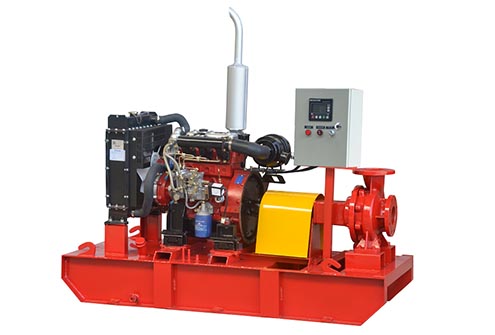The diesel engine fire pump has the characteristics of good start, strong overload capability, compact and reasonable structure, convenient maintenance, simple and reliable use, etc. It is often used in large-scale project engineering emergency water supply projects such as high-rise buildings, water companies, steel plants, wineries, chemical plants, hotels, hospitals, etc. The diesel engine fire pump has perfect indication system: ready to start, manual start, automatic start, unit operation, unit shutdown, battery charging, overspeed, low diesel engine oil pressure, low supercharger oil pressure, low diesel engine oil temperature, high diesel engine cooling water temperature, low battery voltage, low fuel oil level (or lacking), low diesel engine cooling water temperature, and the inspection regularly.
There are two kinds of water inlet modes for diesel engine fire pumps: self-irrigation and self-suction. According to the requirements of fire protection regulations, they are generally self-irrigation water diversion methods. They are mainly composed of diesel engine, fire pump and control system, which meet the various functions and requirements of automatic diesel engine fire pump group - The diesel engine fire pump has a fully automatic control design with multiple selection control modes such as manual control, automatic program control, remote control, and forced start. The diesel engine fire pump is not restricted by the suction stroke, with high slag absorption efficiency, thorough dredging, no auxiliary vacuum pump needed, the cheaper investment, no auxiliary stirring or spraying device, simpler operation, no complicated construction when the motor is under the water, no ground protection and fixtures makes management easier.
In actual use, there are many reasons for the excessive temperature of the diesel engine fire pump, which the common ones include:
1. The diesel engine is overloaded. For this reason, in the operation of the diesel engine fire pump, it is necessary to avoid the high-speed overload operation of the diesel engine;
2. The oil temperature adjustment switch is not in proper position. In summer, the oil does not pass through the radiator to dissipate heat;
3. The diesel engine fire pump oil radiator is blocked, which results in poor heat dissipation;
4. The cooling fan speed of the air cooler is too low, resulting in a decrease in cooling strength, which increases the temperature of the diesel engine;
5.The cylinder leaks, and the high temperature gas breaks into the oil sump and heats the oil of the oil sump.
If the diesel engine fire pump set is automatic control, a solenoid valve is added in parallel with the ball valve on the heat exchange line. Under normal circumstances, the solenoid valve is closed, the cooling water can meet the engine cooling requirements through the gate valve. When the engine cooling water temperature exceeds 95°C, the diesel engine fire pump will automatically open, increase the cooling water flow, lower the engine water temperature of the cooling water, after 20 seconds, if the water temperature of the diesel engine fire pump still exceeds 95 °C, the automatic control system will sound and light alarm, call the staff to the site to check the cause.
The main heat dissipation methods of diesel engine fire pumps can be divided into two types: wind heat dissipation and water heat dissipation. According to the two heat dissipation principles, the water dissipation system has uniform heat dissipation and good heat dissipation effect. The relative price is also relatively low, so most diesel engine fire pumps mainly use water to dissipate heat. Wind heat is divided into natural wind and forced wind. Natural wind is the airflow that comes in from the surface of the machine during the movement, and directly cools the cylinder head, cylinder and other parts. Forced wind means that the fan is used to improve the heat sink. The airflow at the location increases the cooling rate and area. The principle of water dissipation is to use water or antifreeze as the cooling medium to take away the heat of the high-temperature parts of the diesel engine fire pump engine to ensure the normal working temperature.

